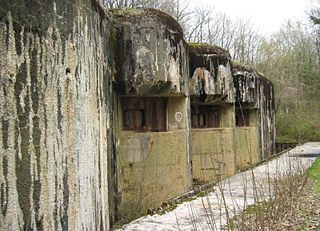
Ouvrage Latiremont is a gros ouvrage of the Maginot Line, located in the Fortified Sector of the Crusnes, sub-sector of Arrancy. It lies between the gros ouvrage Fermont and the petit ouvrage Mauvais Bois, facing Belgium. The village of Doncourt-Cités is nearby. Latiremont was active in 1939-1940, coming under direct attack in late June 1940. It surrendered to German forces on 27 June. After renovations during the Cold War, it was abandoned.

Ouvrage du Kobenbusch is a gros ouvrage of the Maginot Line, located in the Fortified Sector of Thionville in the Cattenom Forest. It possesses seven combat blocks and two entrance blocks, one for ammunition and the other for men. It is located between petit ouvrage Bois-Karre and petit ouvrage Oberheid, and was named for the surrounding Kobenbusch Forest.

Ouvrage Hochwald is a gros ouvrage of the Maginot Line, one of the largest fortifications in the Line. Located on the Hochwald ridge in the Fortified Sector of Haguenau in the community of Drachenbronn-Birlenbach in the Bas-Rhin department of northeastern France, it was designed to protect the northern Vosges region of France. Ouvrage Hochwald is sometimes considered as two ouvrages because of its separation of the western and the eastern portions of the ouvrage. Uniquely, the original plans for the position included an elevated battery to the rear with long-range 145 mm or 155 mm gun turrets of a new kind. Hochwald is used by the French Air Force as an armoured air defense coordination center.
Ouvrage Bovenberg is a lesser work of the Maginot Line. Located in the Fortified Sector of Boulay, the ouvrage is located between petits ouvrages Berenbach and Denting, facing Germany. It consists of two infantry blocks and two artillery blocks.
Ouvrage Mottenberg is a lesser work of the Maginot Line. Part of the Fortified Sector of Boulay, the ouvrage consists of one entrance block and two infantry blocks, and is located between petits ouvrages Coume Annexe Sud and Kerfent, facing Germany.
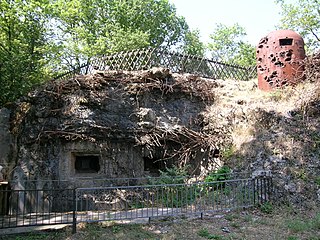
Ouvrage Bambesch is a lesser work of the Maginot Line. Located in the Fortified Sector of Faulquemont, the ouvrage consists of three infantry blocks, and is located between petits ouvrages Kerfent and Einseling, facing Germany. Completed in 1932, it is located in the Bois de Bambesch. On 20 June 1940 during the Battle of France, Bambesch was attacked by German forces, whose artillery battered the position, which could not be effectively supported by its neighbors, into surrender. Since 1973, Bambesch has been operated as a museum and is open to the public.
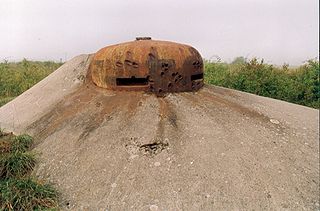
Ouvrage Laudrefang is a lesser work of the Maginot Line. Located in the Fortified Sector of Faulquemont, the ouvrage consists of one infantry block, and is located between petits ouvrages Einseling and Teting, facing Germany. Laudrefang was originally planned as a gros ouvrage. With a heavy armament for a petit ouvrage it successfully defended its neighbors against German attack during the Battle of France. Laudrefang is abandoned and flooded, and was heavily damaged by German bombardment in 1940.
Ouvrage Mauvais-Bois is a petit ouvrage of the Fortified Sector of the Crusnes on the Maginot Line. It is located between the gros ouvrage Latiremont and the petit ouvrage Bois-du-Four, facing the Belgium/Luxembourg border. The original plan for the position was for two phases of construction, resulting in a gros ouvrage provided with heavy artillery. The increase in tension between France and Germany in the late 1930s caused resources to be diverted elsewhere, and only the first three combat blocks were built. In 1940 the ouvrage was regularly bombarded, but not directly attacked by German infantry. When the French military divested itself of the majority of the Maginot fortifications, Mauvais-Bois was the second to be sold.
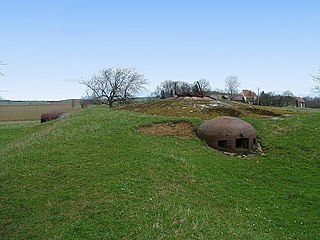
Ouvrage Ferme Chappy is a petit ouvrage of the Maginot Line in northeastern France. It is located at the western end of the Fortified Sector of the Crusnes near Longuyon in the Meurthe-et-Moselle département, facing Belgium. The gros ouvrage Fermont borders Ferme Chappy's artillery coverage to the east. A wide gap existed to the west in the direction of Longuyon, covered only by blockhouses and natural obstacles such as rivers. Ferme Chappy was assaulted by German forces during the Battle of France in June 1940, fending off the attack with artillery support from Fermont. Chappy surrendered with its neighbors on 27 June. It was abandoned after the war and is now private property.

Ouvrage Bois-du-Four is a lesser work in the Fortified Sector of the Crusnes of the Maginot Line. The ouvrage consists of a single large combat block without an underground gallery system, and is located between petit ouvrage Mauvais-Bois and gros ouvrage Bréhain, facing Luxembourg. A planned expansion, never carried out, was intended to enlarge Bois-du-Four into a fully equipped gros ouvrage. Bois-du-Four saw little action in either the Battle of France in 1940 or the Lorraine Campaign of 1944. It is preserved by the community of Villers-la-Montagne and may be visited.
Ouvrage Bréhain is part of the Fortified Sector of the Crusnes of the Maginot Line, located near the community of Bréhain-la-Ville in the Meurthe-et-Moselle department of France. Bréhain is flanked by petits ouvrages Mauvais Bois and Aumetz. The gros ouvrage was equipped with long-range artillery, and faced the border with Luxembourg. It saw no major action in either the Battle of France in 1940 or the Lorraine Campaign of 1944. While not open to public visitation, it has been secured and is in relatively good condition when compared to other abandoned Maginot positions. A flanking casemate has been restored and may be visited.
Ouvrage Aumetz is a small work, or petit ouvrage of the Maginot Line. It is part of the Fortified Sector of the Crusnes and is located near the community of Aumetz in the Moselle département of France. The petit ouvrage flanked by the gros ouvrages Bréhain and Rochonvillers, all facing the France-Luxembourg border. Aumetz was initially planned as a gros ouvrage of six combat blocks, but only three infantry blocks were built. Aumetz saw limited action during the Battle of France. In the 1970s it was the first Maginot position to be offered for sale to the public.
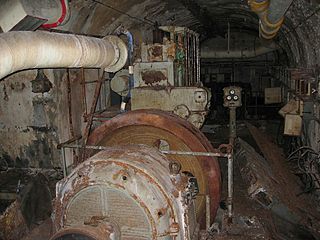
Ouvrage Soetrich is a gros ouvrage of the Maginot Line in north-eastern France. Soetrich is located between petits ouvrages Immerhof and Bois Karre, facing the France-Luxembourg border near the town of Hettange-Grande, part of the Fortified Sector of Thionville. Compared with other gros ouvrages, Soetrich is compact in arrangement, with the entries and underground ammunition magazines and barracks in close proximity to the combat blocks, accessed through underground galleries at an average depth of 30 metres (98 ft). Its primary purpose was to cover the main road to Luxembourg, just to the west. Along with its neighbours, Ouvrage Rochonvillers and Ouvrage Molvange, Soetrich was used during the Cold War as a secure command centre for NATO forces.

Ouvrage Galgenberg forms a portion of the Fortified Sector of Thionville of the Maginot Line. It is situated in the Cattenom Forest, near the gros ouvrage Kobenbusch and petit ouvrage Oberheid. The ouvrage was tasked with controlling the Moselle Valley and as such was called the "Guardian of the Moselle." Galgenberg did not see significant action in 1940 or 1944. After a period of reserve duty in the 1950s and 1960s, it was deactivated. It is now a museum.

Ouvrage Otterbiel forms part of the Maginot Line in the Fortified Sector of Rohrbach, Sub-sector of Bitche, and is located on the Camp de Bitche of the French Army. It is located between gros ouvrage Schiesseck and petit ouvrage Grand Hohekirkel. Part of the Fortified Sector of Rohrbach, the petit ouvrage comprises four combat blocks and an entry block. Due to budget restrictions, a planned flanking infantry block was never constructed. Otterbiel saw no significant action in the Battle of France, and limited action during the 1944/45 Lorraine Campaign. It was renovated for use during the Cold War. Otterbiel is used for ammunition storage by the French Army.

Ouvrage Simserhof is a gros ouvrage of the Maginot Line, located in the French commune of Siersthal in the Moselle department. It faces the German border and is adjoined by the petit ouvrage Rohrbach and the gros ouvrage Schiesseck. Located 4 km west of Bitche, the ouvrage derived its name from a nearby farm. It was part of the Fortified Sector of Rohrbach. During the Battle of France in 1940, the Simserhof supported its neighboring fortifications with partially successful covering artillery fire. After the surrender of France, it was repurposed by the Germans as a torpedo storage depot, and later resisted the American advances of late 1944. The Americans briefly occupied the fort in the first days of 1945 until the German counter-offensive of Operation Nordwind, which allowed them to take back control of the Simserhof. The fort was finally liberated by the 100th Infantry Division on March 15, 1945. Following the war, it was initially repaired for the French Army and later converted into a Maginot Line museum in the early 1960s. Retained by the Ministry of Defense, Simserhof now functions as a museum, and has the most extensive visitor infrastructure of any of the preserved Maginot fortifications.
Ouvrage Schiesseck is a gros ouvrage of the Maginot Line, located near Bitche in the French département of Moselle. Schiesseck is adjoined by gros ouvrage Simserhof and petit ouvrage Otterbiel, all part of the Fortified Sector of Rohrbach, and faces the German frontier. Schiesseck saw comparatively little activity during the Battle of France, surrendering with other positions in its sector on 30 June 1940. During the Lorraine Campaign of 1944 Schiesseck was occupied by German forces and presented a point of resistance to American advances, requiring heavy bombardment and infantry assaults by engineer units to capture. The area was abandoned during the Battle of the Bulge, but was recaptured in March 1945. In the 1950s Schiesseck was repaired as part of a program to re-arm the Maginot Line against a potential advance by Warsaw Pact forces. It was abandoned in the early 1970s. Schiesseck is on military land and is not visitable by the public.
Ouvrage Vélosnes is a gros ouvrage of the Maginot Line, located in the Fortified Sector of Montmédy between the towns of Othe and Vélosnes, facing Belgium. It possesses four combat blocks and one entrance block. It is located to the east of petit ouvrage Thonnelle. The position was sabotaged and abandoned by French forces that were ordered to retreat from the exposed position in June 1940 during the Battle of France. The ouvrage is abandoned and is administered as a nature preserve.

Ouvrage Thonnelle is a petit ouvrage of the Maginot Line, located in the Fortified Sector of Montmédy between the towns of Thonnelle and Verneuil-Petit, facing Belgium. It possesses four combat blocks. It is located between gros ouvrages Vélosnes and Chesnois. The position was sabotaged and abandoned by French forces that were ordered to retreat from the exposed position in June 1940 during the Battle of France. The ouvrage is abandoned.

Ouvrage Chesnois, also known as Ouvrage Chênois, is a gros ouvrage of the Maginot Line, located in the Fortified Sector of Montmédy, facing Belgium. The ouvrage lies between the towns of Montlibert and Thonne-le-Thil. It possesses six combat blocks. It is located between gros ouvrage Thonnelle and petit ouvrage La Ferté. The position was sabotaged and abandoned by French forces that were ordered to retreat from the exposed position in June 1940 during the Battle of France. The ouvrage is now abandoned and sealed.

















